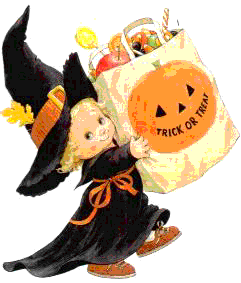Celtic: The ancient Celtic (Irish, Scottish, Welsh) festival
called Samhain is thought by many to be the beginnings of our Halloween
as we know it today. Samhain was the New Year's Day of the Celts, celebrated
on November 1. It was also a day of the dead, a time when it was
believed that the souls of those who had died during the year were
allowed access to the land of the dead. Some of the customs associated
with Samhain, include the night of the wandering dead which is the practice
of leaving offerings of food and drink by masked and costumed people, and
the lighting of bonfires. This continues to be practiced on October 31st,
known as the Eve of All Saints, the Eve of All Hallows, or Hallow Even.
It is the shortening of the name Hallow Even that has given us the name
Hallow e'en.
England: Guy Fawkes Day, November 5th, is celebrated in
ways similar to Halloween. Guy Fawkes was accused of attempting to blow
up the Houses of Parliament on that day in 1605. He was caught and hanged.
On November 5th, 1606, the same Parliament declared the fifth of November
a day of public thanksgiving. The act of treason was viewed as part of
a plot against the Protestant government. English children made dummies
known as Guys. They set them out on street corners and beg passers-by for
"a penny for the Guy". The eve of the fifth is know as Mischief Night,
when children are free to play pranks on adults. On the night of November
5th, the Guys are burned in bonfires, just as the ancient Celts burned
bonfires on November 1st.
Germany: Throughout the Western world, May 1st, like November
1st, is a day of importance. Witches are supposed to be especially active
this day, as are spirits of the dead and demon creatures from the nether
world.
China: The care of the dead through prayers and sacrifices were
part of a spring festival of purification and regeneration.
Japan: Bon festival, dedicated to the spirits of ancestors,
for whom special foods are prepared, occurs during the middle of the summer
(one of the most important festive periods of the year). Three days long,
it is a time when everyone goes home (similar to our American Thanksgiving).
Mexico and other Latin American countries: The first and second
of November are the Days of the Dead -El Dias de los Muertos. In some regions,
the evening of October 31st is the beginning of the Day of the Dead Children,
which is followed on November 1st by the Day of the Dead Adults. Skeleton
figures-candy (sugar skulls), toys, statues and decorations, are seen everywhere.
It is a time for great festivity, with traditional plays and food. It is
a time to play with death and decorating family graves, which is preceded
by religious services and followed by picnics. The human skeleton or skull
is the primary symbol of the day. Unlike the American Halloween, in Mexico
people build home altars, adorned with religious icons and special breads
and other food for the dead.

The Celtics that lived in what is now Great Britain and Northern France
would carry a lantern when they walked on the eve of October 31. These
lanterns were carved out of big turnips and the lights were believed to
keep the evil spirits away. Children would carve faces in the turnips.
These carved turnips were called "jack-o-lantern."
Legends have it that the "jack-o-lantern" got its name
from a stingy and mean old man, named Jack, who when he died was too mean
to get into heaven. When Jack went to hell he was meet by the Devil who
gave him a piece of burning coal and sent him away. Jack placed the burning
coal in a turnip to use as a lantern to light his way. The legends claim
that Jack is still walking with the lantern looking for a place to stay.
When the early settlers came to America they found the big round orange
pumpkin. Being larger and much more colorful than turnips, the pumpkin
made great "jack-o-lantern" Eventually the pumpkin would replace
the turnip.
As the settlers spread across America they took their Halloween celebrations
with them. The custom of the "jack-o-lantern" would travel with
them. Eventually the Pumpkin would become the most widely recognized symbol
of the Halloween holiday.

The history of "Trick'O'Treating" can be traced back to the early celebrations of All Soul's Day in Britain. The poor would go begging and the housewives would give them special treats called "soulcakes". This was called "going a-souling", and the "soulers" would promise to say a prayer for the dead.
Over time the custom changed and the town's children became the beggars.
As they went from house to house they would be given apples, buns, and
money. During the Pioneer days of the American West, the housewives would
give the children candy to keep from being tricked. The children would
shout "Trick or Treat!".